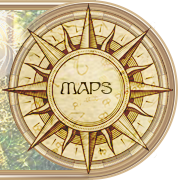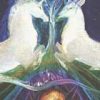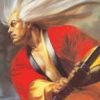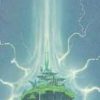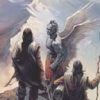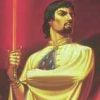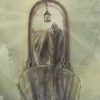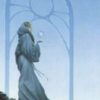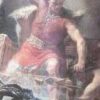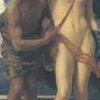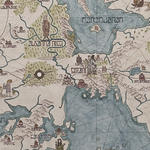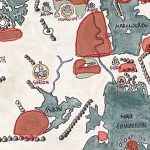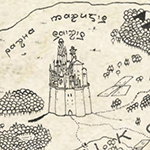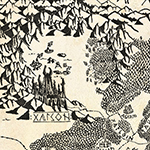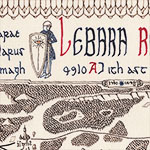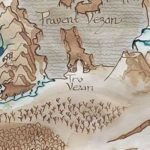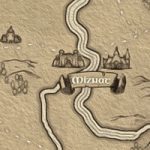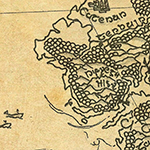0: AGE OF CREATION
In this Age, the primaeval forces in their undisintegrated wholesomeness braided together, weaving the fabric of phenomena inside the Primaeval Being before the Father of the Dividers shattered its crystal-clear consciousness into smithereens that gave rise to the souls of all creatures. Legends have it the consciousness of the Primaeval Being had the form of mirror-like celestial waters and that the Divider (known also as Zilath and Baoth) made another one, identical in appearance, in his own realm. Then, when one mirror gazed into the other, the reflections of reflection shattered into fractions of vision in time, and ten thousand souls rose to existence.
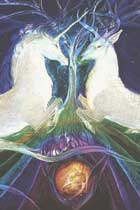 It is said that while the Mirror of the Celestial Waters shattered into the many consciousnesses of individual beings, Zilath’s mirror remained whole and submerged once more into the depths, where it lies to this day. All who look into it gaze into the eyes of The Other – they will die as well as not die through their very selves and will hence inhabit the infinitely small space between Death and Immortality. There, after the fashion of their Master, they will flee from Order until they meet the Pilgrim, who, to their eyes, walks these lands backwards.
It is said that while the Mirror of the Celestial Waters shattered into the many consciousnesses of individual beings, Zilath’s mirror remained whole and submerged once more into the depths, where it lies to this day. All who look into it gaze into the eyes of The Other – they will die as well as not die through their very selves and will hence inhabit the infinitely small space between Death and Immortality. There, after the fashion of their Master, they will flee from Order until they meet the Pilgrim, who, to their eyes, walks these lands backwards.
Others describe the Age of Creation differently; not only they use different words – they tell a different story. We relay what we have heard among the sages in Sirgon and what was confirmed by the Harkening Ones to be the words of the Emperor.
1: AGE OF SILENCE
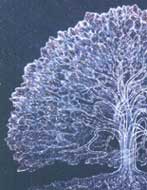 The Age of Silence is said to be the most beautiful of the Ages of Grand. During this Age, all powers were in harmony, and any strife that may have arisen resembled dancing. Most things and forces were fully unrestrained and free; whirling around, they were discovering the best positions through the most splendid of movements. This age witnessed the rise of primaeval stars, water and light in the form of liquid amber gas. The Un-Born appeared as harmonious knots in the fundamental streams of the forces.
The Age of Silence is said to be the most beautiful of the Ages of Grand. During this Age, all powers were in harmony, and any strife that may have arisen resembled dancing. Most things and forces were fully unrestrained and free; whirling around, they were discovering the best positions through the most splendid of movements. This age witnessed the rise of primaeval stars, water and light in the form of liquid amber gas. The Un-Born appeared as harmonious knots in the fundamental streams of the forces.
In this age, clear crystals were formed; it also marked the beginning of music as a form of finding the best place. It is said this is the only time when Tho is young; in all others ages he is an old man who has never been born, nor experienced the years of youth.
2: AGE OF SERFDOM
In the Age of Serfdom, Baoth saw strange omens in the Supercaelium and realized he was alone. He never considered the Un-Born as beings, only as flaws in the yarn, and so he felt a desire to be seen. He wanted more than to be the content of his own consciousness – for then a dream or fantasy would have the same value as reality –; he craved to appease his fear of his non-existence through being watched from more than one point, thus extricating himself from the one-dimensional space and approaching a place his nature had always yearned for.
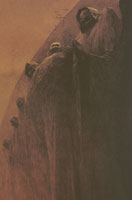 Therefore, he caught the fragments of the Celestial Mirror and from them created beings to fill the world with. He let them worship him as the only God, endowing them with psychical organs in such a way that emotions and energies arose in them whenever they performed rituals to commemorate his existence and power. Moreover, he found these beings had their own tendencies derived from the fragment of the Mirror and so he used these to awaken other forces. The design of the rituals was such that during their performance, the worshippers were prone to kill and torture their neighbours, to procreate with and devour one other. Thus, to his greatest satisfaction, Baoth was constantly being whipped and lashed by the most primitive, powerful energies. He forced those beings to incessantly think about him, to remind themselves of him many times a day – upon waking, before and after meals, before going to sleep and during all important activities. In this way, he was the ever-present content of many a human consciousness. He was powerful and great but wanted more.
Therefore, he caught the fragments of the Celestial Mirror and from them created beings to fill the world with. He let them worship him as the only God, endowing them with psychical organs in such a way that emotions and energies arose in them whenever they performed rituals to commemorate his existence and power. Moreover, he found these beings had their own tendencies derived from the fragment of the Mirror and so he used these to awaken other forces. The design of the rituals was such that during their performance, the worshippers were prone to kill and torture their neighbours, to procreate with and devour one other. Thus, to his greatest satisfaction, Baoth was constantly being whipped and lashed by the most primitive, powerful energies. He forced those beings to incessantly think about him, to remind themselves of him many times a day – upon waking, before and after meals, before going to sleep and during all important activities. In this way, he was the ever-present content of many a human consciousness. He was powerful and great but wanted more.
However, his greedy desire brought him to ruin. He extended his realm, increasing the power of his delights and that of the suffering of his serfs to the very limit of what their essence, derived from the celestial fragments, could bear. In the end, the black cloud of his empire and the screams of the tortured consciousnesses attracted the attention of the Forces of Light.
3: AGE OF THE ENDLESS WAR
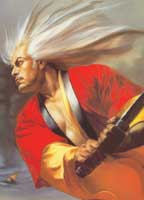 Clad in the tattered robes of beggars, three gods wandered the world watching the inferno that Zilath had created. Lightbringer took upon him the shape of the Cosmic Tree, turning himself into the first sign of a great change. A great war erupted between the Azhars and Zilath, a conflict in which everything was transformed, torn apart and set against all else. The war was without end: the roots of light of the Azhar were far away, without this world, though their power was unimaginable, but Zilath, being its creator, knew the world better than himself and his power within its reaches was also immense.
Clad in the tattered robes of beggars, three gods wandered the world watching the inferno that Zilath had created. Lightbringer took upon him the shape of the Cosmic Tree, turning himself into the first sign of a great change. A great war erupted between the Azhars and Zilath, a conflict in which everything was transformed, torn apart and set against all else. The war was without end: the roots of light of the Azhar were far away, without this world, though their power was unimaginable, but Zilath, being its creator, knew the world better than himself and his power within its reaches was also immense.
4: AGE OF ELEMENTS
When the Powers grew weary of the endless and undecided clashes, they entered a state of unstable equilibrium. The world was torn and mingled in a great storm of the Elements where places protected by one of the rivalling Powers floated like forlorn islands. The war still raged among these islets but now on a purely elemental level – waves of cosmic ice clashed against the fires and the heat of the core, pressures splintered the continents, otherworldly gale blowing through it all.
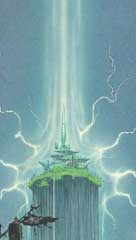 In the Age of the Endless War, many of the celestial folk descended into the world together with the three Azhars, and Zilath had to withstand great multitudes. The Azhars were slowly growing accustomed to the way of this world as well as the matters of the physical body and they became used to Zilath’s schemes. On the other hand, Zilath the Archon had tempted many of the Azhars to his side or let them gaze into the Mirror. This gave rise to a great host of Zilaths, though only seven remained powerful throughout the Ages.
In the Age of the Endless War, many of the celestial folk descended into the world together with the three Azhars, and Zilath had to withstand great multitudes. The Azhars were slowly growing accustomed to the way of this world as well as the matters of the physical body and they became used to Zilath’s schemes. On the other hand, Zilath the Archon had tempted many of the Azhars to his side or let them gaze into the Mirror. This gave rise to a great host of Zilaths, though only seven remained powerful throughout the Ages.
The Age of Elements was a terrible time for the powerless; except for modest shelters, it was impossible to live in. Multitudes were dying and people were few. And yet, in the end, a change occurred. Some of the brave and wise humans of that time learned to join their powers into a single potent current. In this way, they were able to fight against more powerful beings while also resisting the madness of the unleashed Elements. These men took heart and kept gathering power for so long they eventually managed to provide substantial support to the Azharian gods in their war against Zilath.
And so, in the great conflict that occurred at the end of this Age, they were the decisive albeit small weight on the previously balanced scales of power between the Azhars and Zilath, who was thrown down the Precipice. It is said his seven-fingered right hand was cut off in the fight, falling into the world. Possibly it is only a simile – the Lord had left behind his seven Zilaths, the fallen Azhars. This is why in Azharian, these beings are also called “Tenidath”, or Fingers.
5: AGE OF AZHARIANS
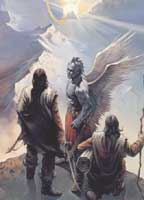 There is not much to tell about the Golden Age as it went on in peace, brightness and the ever-increasing level of knowledge, steadily growing population and the great beauty of all the world’s creation. “Azharians” was the name of the people who descended with the Azhars or educated themselves, becoming so wise they knew the truth about the nature of fragments from the Celestial Mirror. In the preceding Age, these people were the decisive power while in this one, they became kings of all the universe. The world called Grand (or Qurend) took shape, the Elements were bound by Azharian magic, the time was spun into a neat order and space erased wherever possible. Hence, the beginning of this Age bore witness to great creation that continued with the construction of the world of Men and other beings.
There is not much to tell about the Golden Age as it went on in peace, brightness and the ever-increasing level of knowledge, steadily growing population and the great beauty of all the world’s creation. “Azharians” was the name of the people who descended with the Azhars or educated themselves, becoming so wise they knew the truth about the nature of fragments from the Celestial Mirror. In the preceding Age, these people were the decisive power while in this one, they became kings of all the universe. The world called Grand (or Qurend) took shape, the Elements were bound by Azharian magic, the time was spun into a neat order and space erased wherever possible. Hence, the beginning of this Age bore witness to great creation that continued with the construction of the world of Men and other beings.
However, human and Elven cities were being built only initially. Later, the Azharians began to delve further, into the spaces beyond the sigh of ordinary men. They gradually withdrew since their still higher consciousness needed to feast on increasingly fine and complex beauty. They retired from the world into the depths from which few of them ever came forth. Only those who had understood the message hidden in the eyes of the Old Man remained in the world to faithfully guard it and its growing riches.
6: AGE OF MAGHAVANS
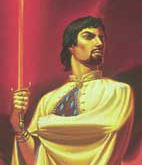 The Age of Maghavans was stark, hard, disciplined, and admirable. The world fell in love with order, and therefore, Orders. These were established by gods and entered by their worshippers. Artists, builders, fighters, and others were all founding own guilds. The most superior of these institutions have survived until the present time: the Order of the Hermeneutics, the Order of the Architects and – the highest of all as well as the ruling order of that Age – the Order of Maghavans.
The Age of Maghavans was stark, hard, disciplined, and admirable. The world fell in love with order, and therefore, Orders. These were established by gods and entered by their worshippers. Artists, builders, fighters, and others were all founding own guilds. The most superior of these institutions have survived until the present time: the Order of the Hermeneutics, the Order of the Architects and – the highest of all as well as the ruling order of that Age – the Order of Maghavans.
7: AGE OF PILGRIMS
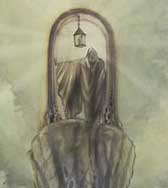 Eventually, the Age of Maghavans, classical, orderly in everything and seemingly inviolable, came to an end. It ended on the impulse of its very founders and protectors; they left for the Desert, which was the only secret still hidden to these sages. The Age of Pilgrims was a peaceful twilight of a glorious world, still warm and clean owing to the shine and splendour of the two previous ages. Pilgrims on their Pilgrimage wandered the world, only gradually leaving it, and not for the want of love. On the contrary, their fondness for the world was obvious; they spoke with the people and passed their wisdom onto them in order to leave some of it behind.
Eventually, the Age of Maghavans, classical, orderly in everything and seemingly inviolable, came to an end. It ended on the impulse of its very founders and protectors; they left for the Desert, which was the only secret still hidden to these sages. The Age of Pilgrims was a peaceful twilight of a glorious world, still warm and clean owing to the shine and splendour of the two previous ages. Pilgrims on their Pilgrimage wandered the world, only gradually leaving it, and not for the want of love. On the contrary, their fondness for the world was obvious; they spoke with the people and passed their wisdom onto them in order to leave some of it behind.
During that time, the stars were close; the Pilgrims rose to them and drank from their nectar. This age resembled the Age of Silence by its elegance and peacefulness, only it was inhabited by millions of beings living together in peace.
8: AGE OF ELVES
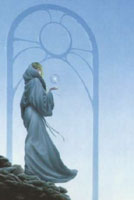 Once the Pilgrims had left, powers that had previously been outshined by the Maghavan strength and did not have a major role in the events of the past came forth from the shadows. It was not so much their wilfulness that was at play but rather the people, who now that their old teachers and rules had gone turned to these new masters in search of guidance.
Once the Pilgrims had left, powers that had previously been outshined by the Maghavan strength and did not have a major role in the events of the past came forth from the shadows. It was not so much their wilfulness that was at play but rather the people, who now that their old teachers and rules had gone turned to these new masters in search of guidance.
During these times, people found support with the wise Elven Princes and the still present Un-Born. The Elves, who always worked together with both the Azharians and Maghavans, naturally became their successors. For long centuries, they ruled over the living magic night of the world as its most competent stewards. They were watchful and relentless. They felt no need to leave for they had no urge to reach ever further – which was the nature of the Azharians and of Maghavans, their more powerful predecessors.
9: AGE OF GODS
The end of the Elven rule was brought about by the Gods of Grand, who had slowly woken into the understanding that the powerful beings previously hindering them had left for the Pilgrimage. Their power was spreading among the people already during the reign of the Elves, though tentatively at first and without conflict with the Elven intention.
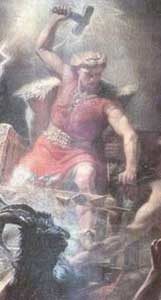 However, once they felt the number of their supporters had risen sufficiently, once some of the thoughts they had been sowing among the people finally matured, these beings entered into open resistance. The Gods of Grand had always been a selfish lot with no regard for anything apart from the very values they themselves incarnated. Nevertheless, except for this pride and blindness, they were not particularly destructive. But there were other forces at work during that time – the seven Zilaths posing as gods and igniting conflict. The Zilaths made good use of the attributes inherited from their absent Master, namely the ability to pass as anyone or anything with enough persuasiveness to fool the gods themselves.
However, once they felt the number of their supporters had risen sufficiently, once some of the thoughts they had been sowing among the people finally matured, these beings entered into open resistance. The Gods of Grand had always been a selfish lot with no regard for anything apart from the very values they themselves incarnated. Nevertheless, except for this pride and blindness, they were not particularly destructive. But there were other forces at work during that time – the seven Zilaths posing as gods and igniting conflict. The Zilaths made good use of the attributes inherited from their absent Master, namely the ability to pass as anyone or anything with enough persuasiveness to fool the gods themselves.
The only ones in the ranks of gods who maintained a convincing resistance against the Zilath strategy were the Andals, the Seals of the Five Elements, godly beings who had tended to the beneficiality of the elements from the times of the Binding. Though they did not recognize the Zilaths for what they were, they nonetheless disagreed with their theses and principles.
Despite the Andal resistance, the gods turned the people against the Elves (from this very fact it must have been obvious the Dividers were at play for this is how they work), convincing them they were slaves to the Elven rule and would be better off under their own administration (naturally aided by the wise counsel of their gods). Few hesitated at the realization they were, in fact, changing one slavery for another. Thus came the bloody dawn of the world and with it, disappointment. The Elves, offended at the world, fled back within the borders of their deep woods and protected realms.
Only in the North and the newly formed Sirania, the Elves were not banished, and their influence remained there until our age. In the East, still inhabited by the Maghavans, nothing changed. The calamity was greatest in the South. Of all people, the Southerners are furthest in nature from the Elves and so their resistance was the fiercest. Many beautiful and wise Elves died at the hands of their pupils and former friends. In the West, the situation differed country to country, but the Zilath were at their most active there. Often, the less their corruption seemed obvious, the more terrible it was.
This is how the Age of Gods came to be – a time the Elves, Maghavans and Siranians call the Second Age of Serfdom as in their eyes, it brought about the victory and reign of the Zilaths.
10: AGE OF HEROES
No great divide separates the Age of Heroes from that of the Gods. Still, it began at a specific time when the air started to smell differently, when people’s desires shifted and they started to use different words and admire different things. All the preceding ages had already lied buried with the bones of the Earth, each one of them leaving an inheritance through which the world had become richer and greater. The wars of the Gods and the Elves and the ensuing civil wars between the Gods and the nations could not destroy even one-tenth of what the Azharians, Maghavans and Elves had left behind.
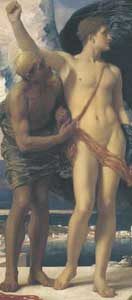 But unlike in the previous ages, the world was now divided into dozens of countries with varying gods and interests, and there was no unifying idea or power to dictate its course. Concealing their true identity, there were Azharians, Maghavans, Elves, Zilaths as well as various gods and powerful individuals settling their affairs in private.
But unlike in the previous ages, the world was now divided into dozens of countries with varying gods and interests, and there was no unifying idea or power to dictate its course. Concealing their true identity, there were Azharians, Maghavans, Elves, Zilaths as well as various gods and powerful individuals settling their affairs in private.
At that time, the Andals, who until then played the role of passive supervisors and guardians, realized there was no one to protect the world against the return of Zilath or some other incarnation of Terror, and woke into action. Having inspected the world from this angle, they realized to their horror that while their side laid dormant, the Zilaths were fully at work, preparing the ground to suit their own purposes. However, unlike in the past, they worked quietly and with great delicacy, and wherever possible, through unsuspecting mediators (the so-called “heroes”). Owing to this strategy, they had been active for centuries without anyone noticing. But the Andals did not want to alert the Zilaths or let them realize they knew about the paths they walked. They had no desire to plunge the world once more into terrible wars of gods where all the inherited and newly built beauty would be undone, and so they devised their own quiet, unseen strategy against them.
Thus, the Age of Heroes came about, and the world was transformed into one intertwined game of chess, where the pieces do not know they are the pieces, and the players are trying their hardest to pretend they are not playing.
Such was the prowess of the rivals that often it was indeed impossible to tell whether there was someone behind a moving piece and whether the opposing side had made a move, or not.
The real understanding of this godly play escapes us, more so because the game is still ongoing, and we are the pieces on the board. Unfortunately, to understand, however vaguely, the way things relate to one another, not within the deceitful veil called reality but in the game itself, we do not have, so to say, a sufficiently detached view.
